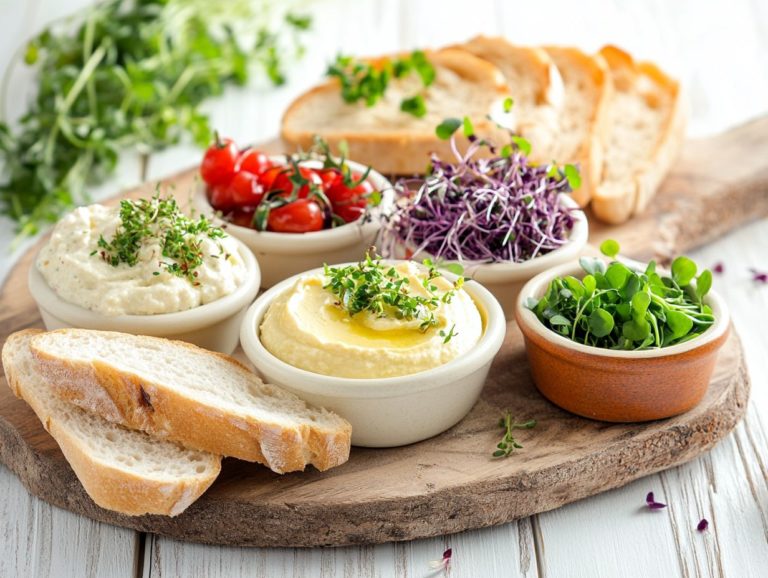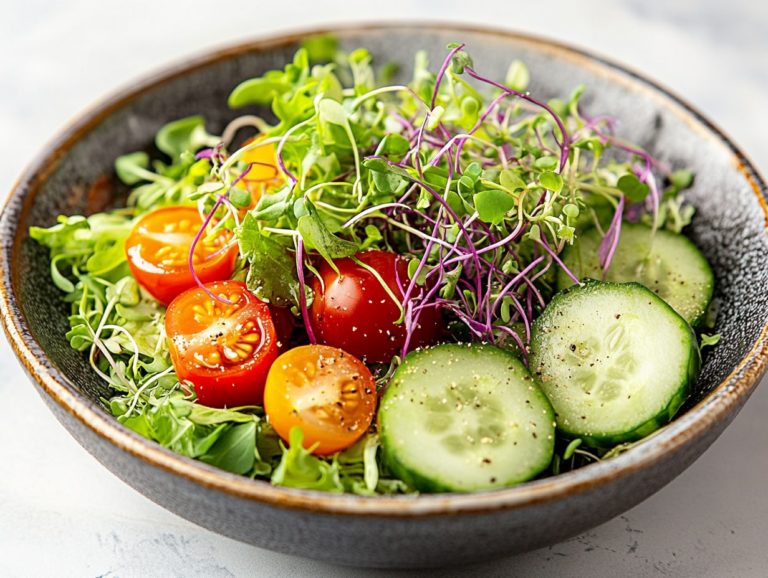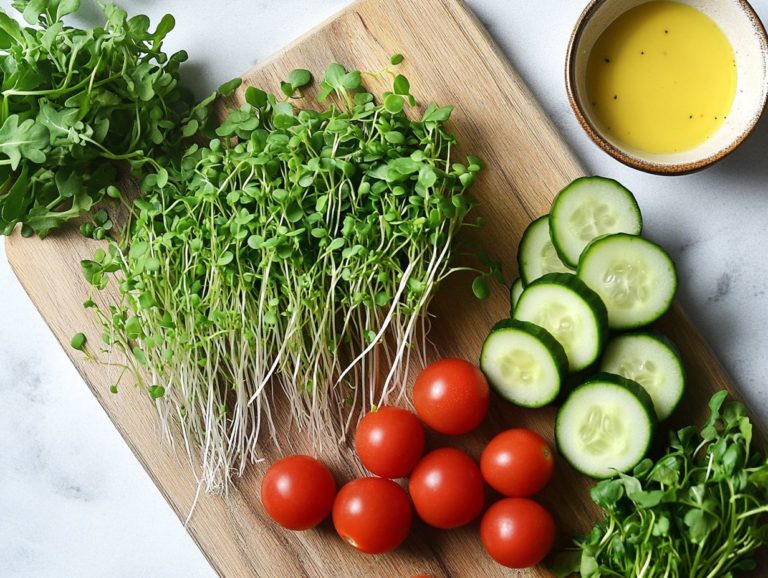61. 5 Unique Microgreen Slaw Recipes
Microgreens are far from mere garnishes; they deliver a robust burst of flavor and nutrition that can truly elevate any dish, making them a staple in many seasonal dishes. Get ready to transform your meals with the power of microgreens!
You ll want to explore five distinctive slaw recipes that highlight the versatility of these tiny greens, offering everything from a zesty Asian twist to a rich creamy avocado blend, including an easy recipe for a delicious homemade slaw.
Dive into the world of microgreens, discovering their various types and the art of incorporating them into your meals, including quick make options for fresh ingredients.
You’ll also learn how to grow your own microgreens, allowing you to enjoy their remarkable nutritional benefits while exploring cooking tips for using them in a variety of recipes.
Contents
- Key Takeaways:
- 1. Tangy Asian Microgreen Slaw
- 2. Spicy Southwest Microgreen Slaw
- 3. Creamy Avocado Microgreen Slaw
- 4. Zesty Lemon Garlic Microgreen Slaw
- 5. Sweet and Savory Microgreen Slaw
- What Are Microgreens and Why Are They Beneficial?
- Frequently Asked Questions
- What are microgreens, and why should you add them to your slaw?
- Can I use any type of microgreens in these slaw recipes?
- What equipment do I need to make these microgreen slaw recipes?
- Do I need to wash the microgreens before using them in the slaw?
- Can I make these slaw recipes ahead of time?
- Are these microgreen slaw recipes suitable for any dietary restrictions?
Key Takeaways:
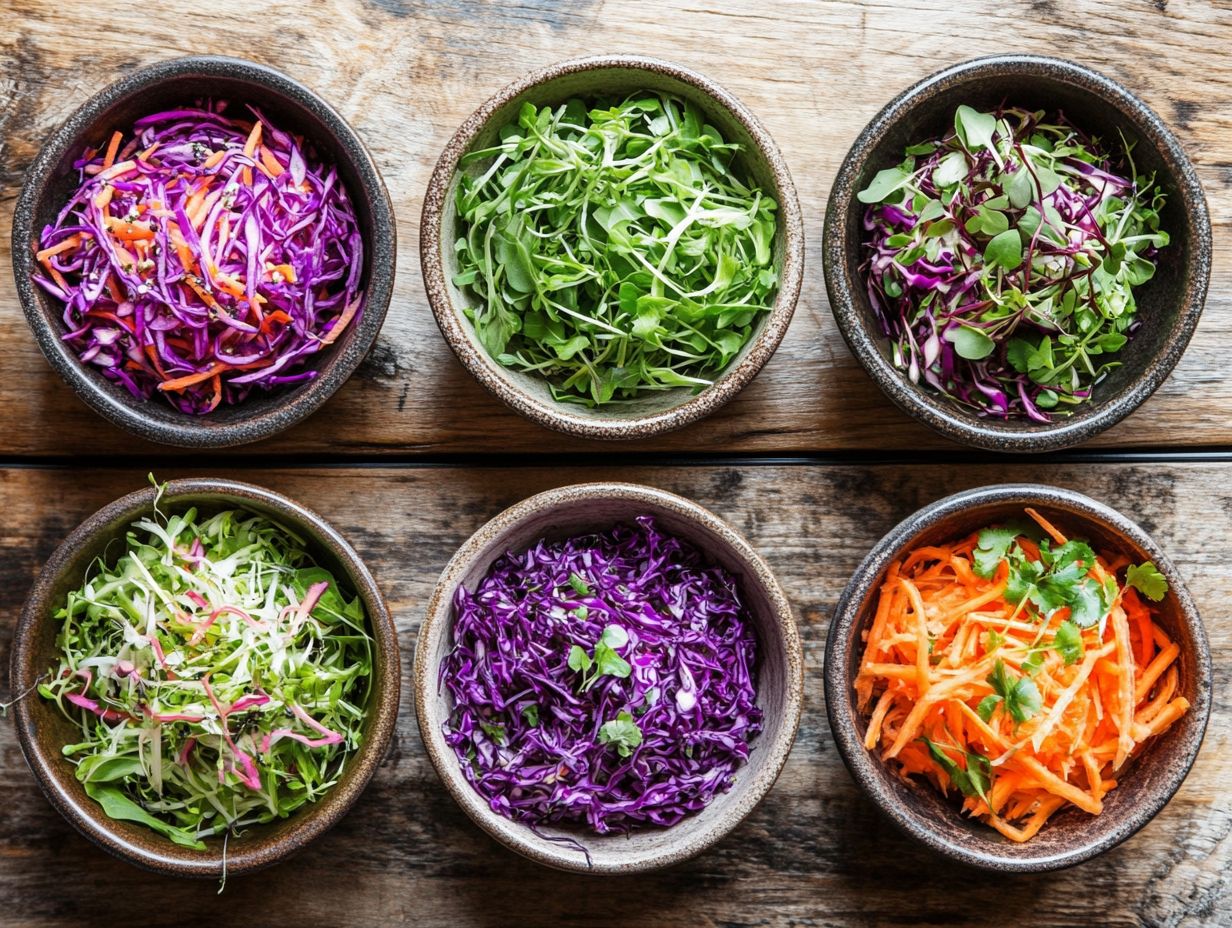
1. Tangy Asian Microgreen Slaw
Tangy Asian Microgreen Slaw is your ticket to vibrant colors and a crisp, refreshing texture that can elevate any meal; it s the perfect side dish for Taco Tuesday or a delightful addition to your summer gatherings, particularly with a tangy dressing that enhances its flavor. This slaw features radish microgreens, adding a unique flavor profile beautifully complemented by a smooth dressing of apple cider vinegar and honey, which adds a delightful vinegar tang to your meal. Every bite offers a delicious crunch and impressive health benefits.
To create this delightful slaw, begin with a generous mix of shredded cabbage and fresh cilantro, then fold in the radish microgreens for that signature peppery bite. For the dressing, whisk together apple cider vinegar, honey, soy sauce, and sesame oil; this tangy sweetness perfectly balances the crunchiness of the vegetables. For the best experience, serve the slaw chilled, allowing those flavors to meld beautifully. Consider adding microgreen toppings for an extra layer of flavor!
Keep in mind that microgreens are full of vitamins and antioxidants, making them great for healthy eating. For an exciting twist, try incorporating must-try microgreen varieties for salads. This slaw is not just a feast for the eyes; it’s a powerhouse of health benefits that will elevate your meals to a whole new level.
2. Spicy Southwest Microgreen Slaw
Spicy Southwest Microgreen Slaw is your ticket to a flavor explosion, celebrating the bold essence of Tex-Mex cuisine with a spicy crunch that will ignite your taste buds. Imagine the vibrant crunch of radish microgreens coupled with the fiery kick of jalape os this slaw is the ultimate crunchy topping for your tacos or burritos, delivering a zesty flavor that everyone will love.
This lively dish also offers a delightful mix of textures and flavors, seamlessly uniting fresh and spicy ingredients for a refreshing yet assertive flavor profile. To whip up this slaw, begin with a base of finely shredded cabbage, then sprinkle in a handful of chopped cilantro for that aromatic lift.
For the dressing, simply whisk together lime juice, olive oil, and a hint of honey or agave to balance out the heat from the jalapeños, delivering a zesty kick that beautifully complements the dish, ensuring a balanced and delicious crunch. By incorporating a variety of microgreens, you can elevate the flavor and enjoy 7 delicious microgreen tapas for sharing, enriching the slaw with essential nutrients, making it a guilt-free addition to any meal.
3. Creamy Avocado Microgreen Slaw
Creamy Avocado Microgreen Slaw offers a fresh twist on traditional slaw. It features a creamy dressing made from ripe avocado, making it a light and delicious option for any meal.
This dressing adds a rich texture and boosts the dish’s nutritional value thanks to the microgreens.
To create the creamy dressing, blend a ripe avocado with a splash of lemon juice, Greek yogurt, a hint of honey, and a sprinkle of salt. Blend until smooth for a dressing that highlights the slaw’s colorful ingredients.
Adding radish microgreens gives a unique peppery kick that pairs perfectly with the creamy avocado.
For assembly, toss the microgreens with shredded cabbage and carrots. Drizzle the dressing over the mix and stir gently to combine.
Serve this refreshing slaw alongside grilled chicken or fish for a delightful flavor contrast.
4. Zesty Lemon Garlic Microgreen Slaw
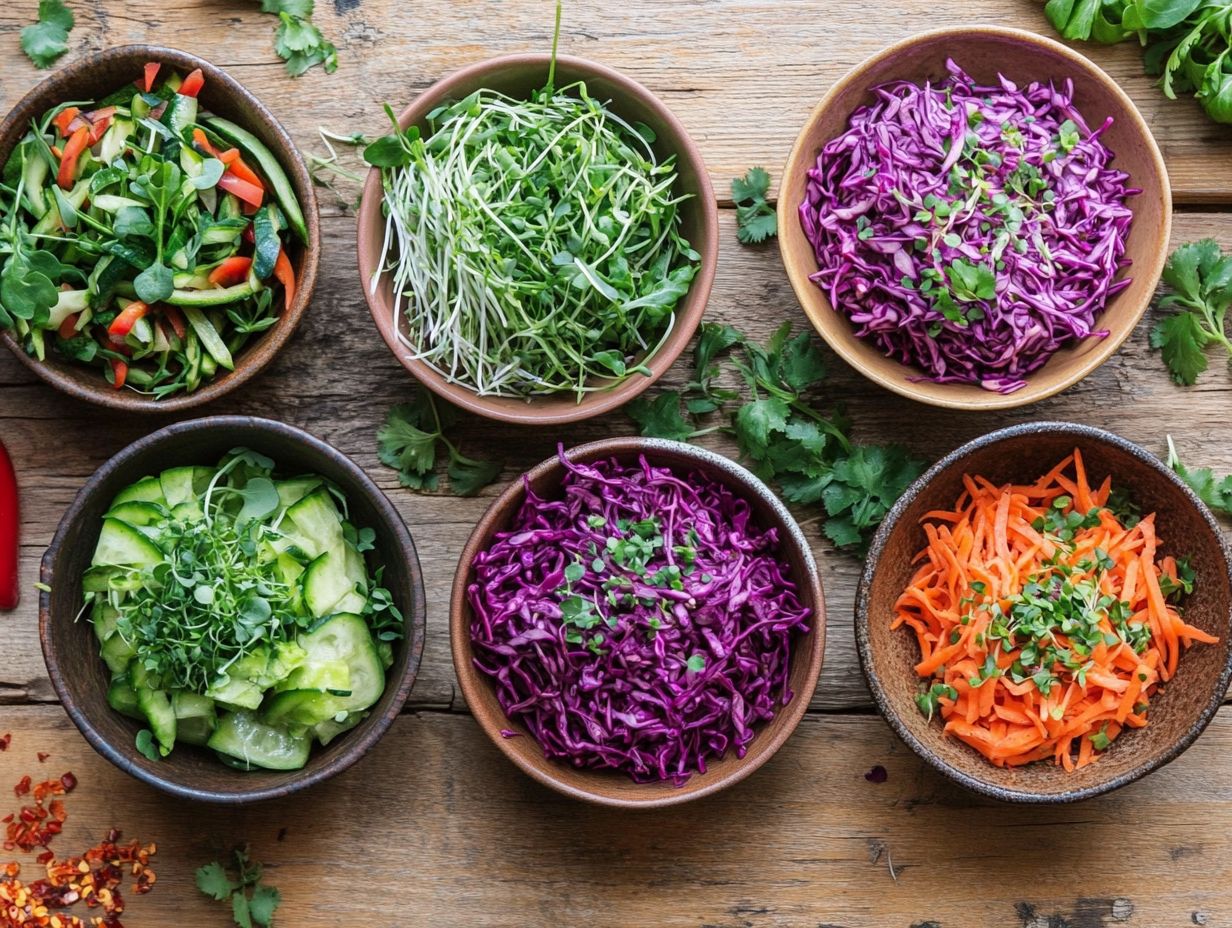
Zesty Lemon Garlic Microgreen Slaw packs a punch with the bright flavors of fresh lemon and garlic. This flavorful slaw is perfect for brightening up any meal.
This dish is a delightful side for your summer barbecues.
To make the dressing, whisk together fresh lemon juice, minced garlic, high-quality olive oil, and a touch of honey for sweetness. This tangy dressing enhances the microgreens beautifully.
A pinch of salt and freshly cracked pepper finish the dressing, balancing the sharp lemon with earthy notes.
Serve the slaw chilled to let the flavors meld. Its vibrant colors and refreshing taste make it an ideal match for grilled meats and light summer fare.
5. Sweet and Savory Microgreen Slaw
Sweet and Savory Microgreen Slaw combines honey’s sweetness with apple cider vinegar’s tang. This unique mix highlights the crunchy texture of fresh microgreens.
The dish features shredded carrots, crisp apples, and finely chopped scallions, coming together for a perfect sweet and savory balance.
Making the dressing is easy whisk together honey, apple cider vinegar, olive oil, and a pinch of salt and pepper. This blend creates a delicious topping.
Incorporating microgreens not only enhances flavor but also adds essential vitamins and antioxidants. This slaw becomes a nutritious addition to any meal.
This combination is both refreshing and satisfying, ensuring your palate is happy while nourishing your body.
What Are Microgreens and Why Are They Beneficial?
Microgreens are vibrant, young edible plants harvested at their peak. They are celebrated for their intense flavors and significant health benefits, making them a key element in any healthy eating plan.
Packed with nutrients, these tiny treasures can elevate any dish from fresh salads to zesty tacos making them an invaluable addition to your healthy eating routine throughout the seasons.
These miniature powerhouses come in a variety of flavors, including arugula, basil, radish, and beet greens. Microgreens also serve as a rich source of vitamins and minerals. Research suggests that microgreens can carry up to 40 times the nutrients of their mature counterparts, underscoring their importance in a balanced diet. Additionally, there are 65.5 creative ways to use microgreens in baking that can enhance both flavor and nutrition.
Whether you sprinkle them on soups or blend them into smoothies, they deliver a burst of flavor and nutrition that supports immune function and overall health.
As more food lovers discover their versatility, microgreens are evolving from mere garnishes to essential components in crafting delicious and nourishing meals, including easy instructions for growing microgreens at home.
What Are the Different Types of Microgreens?
You ll discover a delightful array of microgreens, each with its own unique flavor and nutritional benefits. Think of popular varieties like radish microgreens, cilantro, and beet greens each of which can be easily cultivated at home or sourced fresh from local markets.
These small greens add bright color to your dishes and bring a burst of flavor that can elevate even the simplest recipes. For instance, radish microgreens deliver a peppery kick, making them a fantastic addition to sandwiches and salads. You can explore more ways to use these greens in 73. 5 microgreen recipes for a colorful plate.
Cilantro microgreens provide a fresh, zesty element that’s perfect for salsas and garnishes. Meanwhile, beet greens offer a sweet and earthy essence that pairs beautifully with roasted vegetables or serves as a savory bed for proteins. For more inspiration, check out 5 popular microgreen varieties for cooking.
Cultivating microgreens typically requires minimal space and can thrive indoors or outdoors, needing just a sunny spot and regular watering. By incorporating these greens into your everyday meals, you can enhance the nutritional value the vitamins and minerals foods provide and elevate the flavor profile of a variety of dishes.
How Can Microgreens Be Used in Cooking?

Use microgreens as your secret weapon in the kitchen, elevating dishes from salads and sandwiches to inventive slaw recipes, bringing a flavorful citrus twist to every bite. They not only enhance flavor and visual appeal but also pack exceptional nutritional benefits.
Imagine adding a burst of color, crunch, and taste that transforms even the most traditional recipes into something fresh and contemporary making them ideal toppings for summer meals.
By incorporating a variety of microgreens like arugula, radish, and beet greens, you can elevate simple meals into gourmet experiences. For instance, topping a classic caprese salad with vibrant pea shoots not only gives it a refreshing twist but also enhances its nutrient profile. You can also explore 7 delicious microgreen sandwich recipes to further enhance your meals.
Experimenting with these little greens allows you to turn everyday entrees into healthful masterpieces. You’ll create enriching dishes brimming with vitamins, minerals, and antioxidants, all while delighting the taste buds.
What Are the Nutritional Benefits of Microgreens?
Microgreens are a treasure trove of nutritional benefits, often packing a punch with higher concentrations of vitamins, minerals, and antioxidants compared to their fully grown counterparts. This makes them an exceptional addition to your diet, especially if you’re focused on promoting health and wellness.
For example, broccoli microgreens can boast up to 40 times more cancer-preventive compounds than their mature versions. Radish microgreens are brimming with vitamin C, giving your immune system a solid boost. If you’re looking to incorporate these greens into your meals, check out the best recipes to try. Research published in the *Journal of Agricultural and Food Chemistry* shows how these tiny greens enhance cardiovascular health and reduce inflammation.
Incorporating a variety of microgreens into your meals like salads, smoothies, or sandwiches is a simple yet impactful way to elevate your nutritional intake and cultivate a more vibrant and health-conscious lifestyle.
Where Can One Find Microgreens?
You can find microgreens at farmers’ markets, grocery stores, or specialty shops. You can also grow them at home for fresh ingredients!
When searching for high-quality microgreens, pay attention to vibrant colors and crisp textures. These indicators reflect freshness and nutrient density. At farmers’ markets, engaging with the growers can provide valuable insights into their cultivation practices. If you prefer shopping at stores, look for organic labels that often signify better quality.
Growing microgreens at home allows you to experiment with unique flavors and varieties that align perfectly with your cooking preferences.
How Can One Grow Their Own Microgreens at Home?
Growing microgreens at home is an exciting and rewarding adventure! You can enjoy fresh ingredients throughout the year and whip up recipes that promote healthy eating.
This delightful hobby brightens up your kitchen with vibrant colors and enhances the nutritional profile of your meals. To get started, consider choosing beginner-friendly varieties like radish, sunflower, or basil. For additional inspiration, check out how to use microgreens in traditional dishes. These seeds sprout quickly and flourish indoors, making them perfect for your initial foray into microgreens.
Once you ve selected your seeds, prepare an appropriate growing medium, ensure adequate moisture, and provide enough light for optimal growth.
To maximize your yield, keep the trays in a well-ventilated area and harvest the microgreens when the leaves are young and tender. Fresh microgreens can elevate your salads, sandwiches, or serve as a gourmet garnish for various dishes. For more creative options, check out these microgreens snack platter ideas, imparting delightful flavors while enriching your meals with essential vitamins and minerals.
Frequently Asked Questions
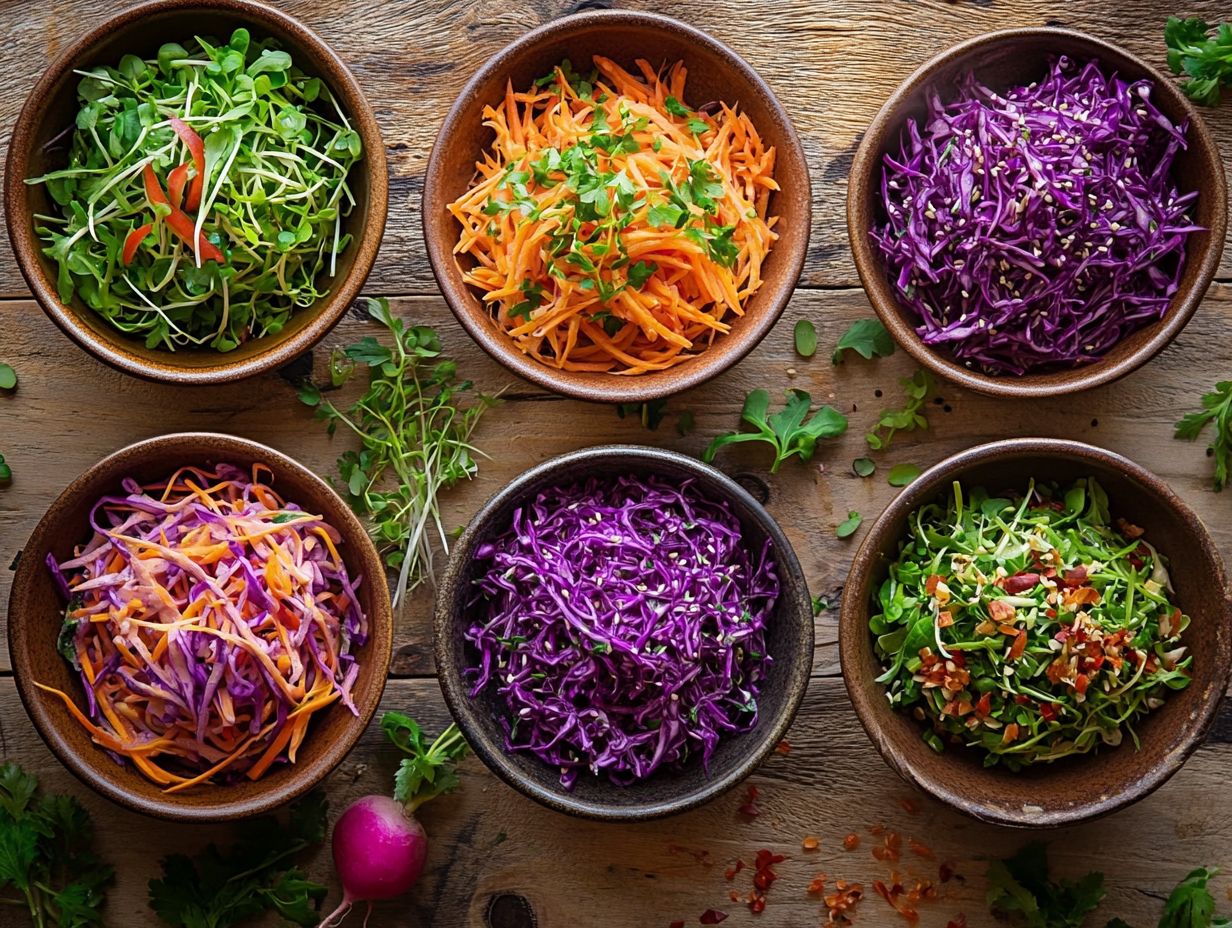
What are microgreens, and why should you add them to your slaw?
Microgreens are young vegetable greens harvested after just a few weeks of growth. They are packed with nutrients and antioxidants, making them a healthy addition to any dish, including slaw.
Can I use any type of microgreens in these slaw recipes?
Yes, you can use any type of microgreens in these slaw recipes. Some popular options include broccoli, sunflower, radish, and pea microgreens.
What equipment do I need to make these microgreen slaw recipes?
All you need is a sharp knife, a cutting board, and a bowl to mix the ingredients. Optional equipment includes a julienne peeler or mandoline slicer for a more uniform slaw texture.
Do I need to wash the microgreens before using them in the slaw?
Yes, it is important to wash the microgreens before using them in any recipe. They can be delicate, so gently rinse them under cold water and pat them dry with a paper towel.
Can I make these slaw recipes ahead of time?
Yes, you can make these slaw recipes ahead of time. However, it’s best to add the dressing right before serving to prevent the slaw from becoming soggy.
Are these microgreen slaw recipes suitable for any dietary restrictions?
Yes, these recipes cater to a variety of dietary needs. They are gluten-free, dairy-free, and vegan-friendly.
Feel free to make changes to suit your preferences. For instance, simply swap in a dairy-free dressing for a delightful vegan option!


